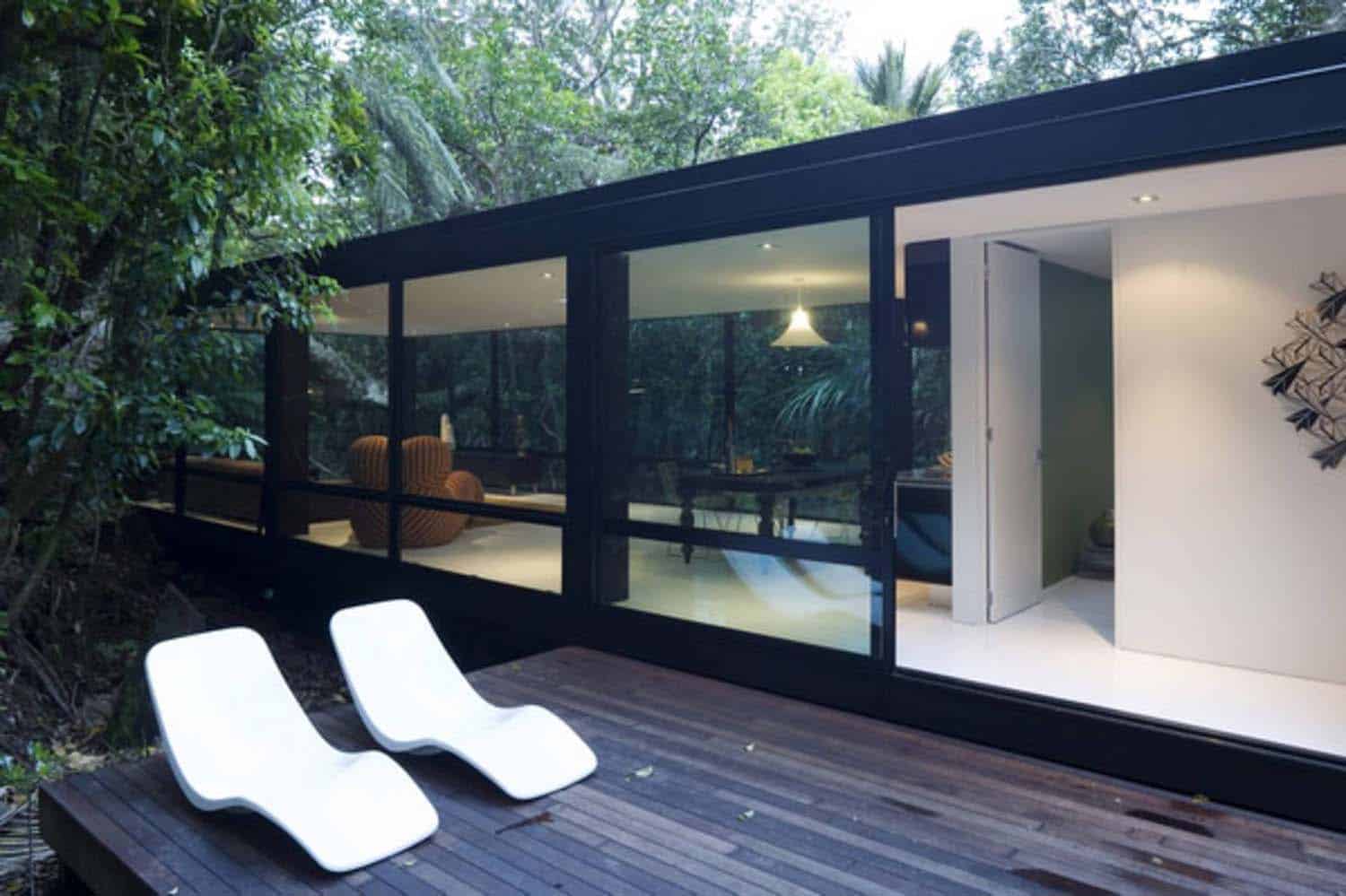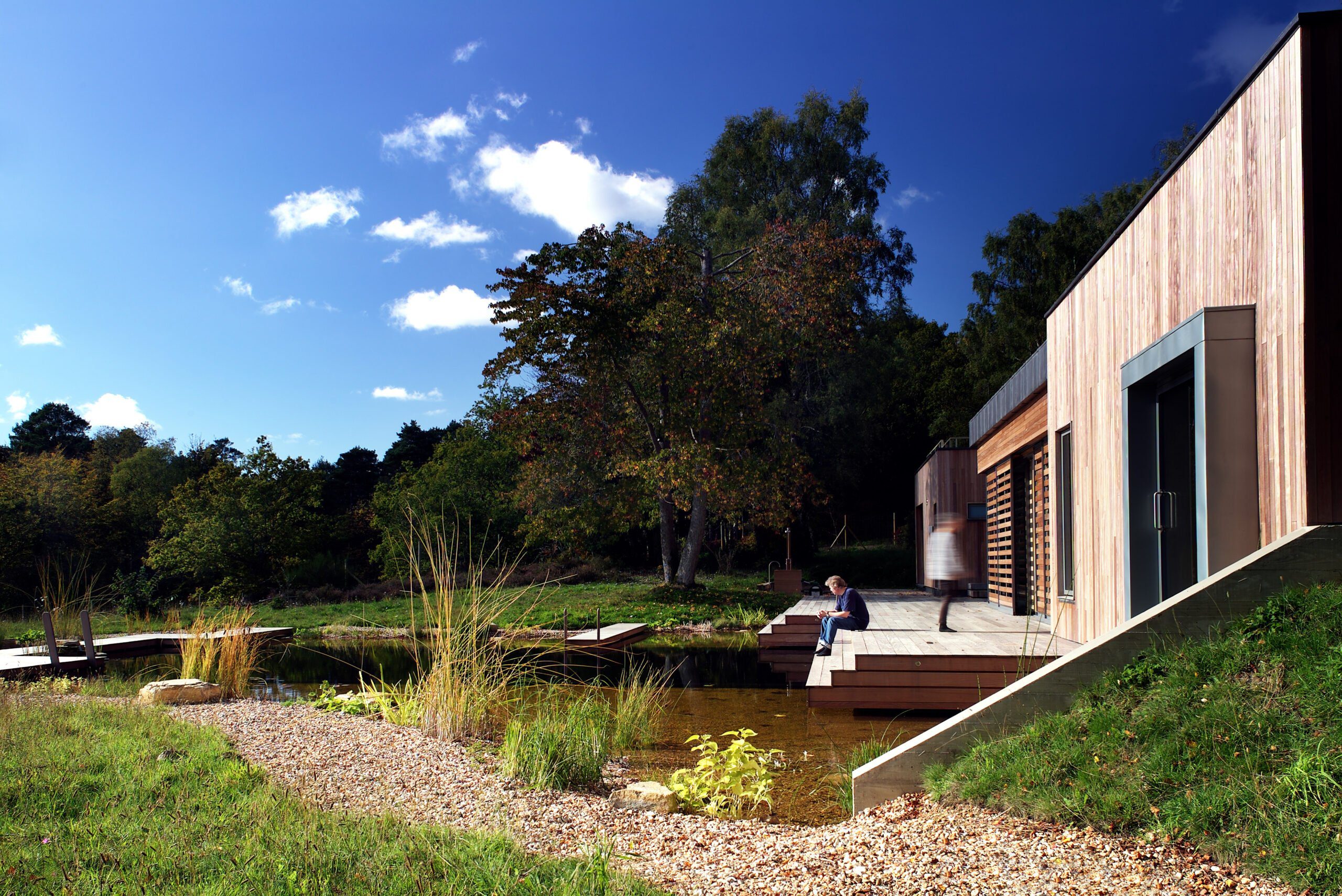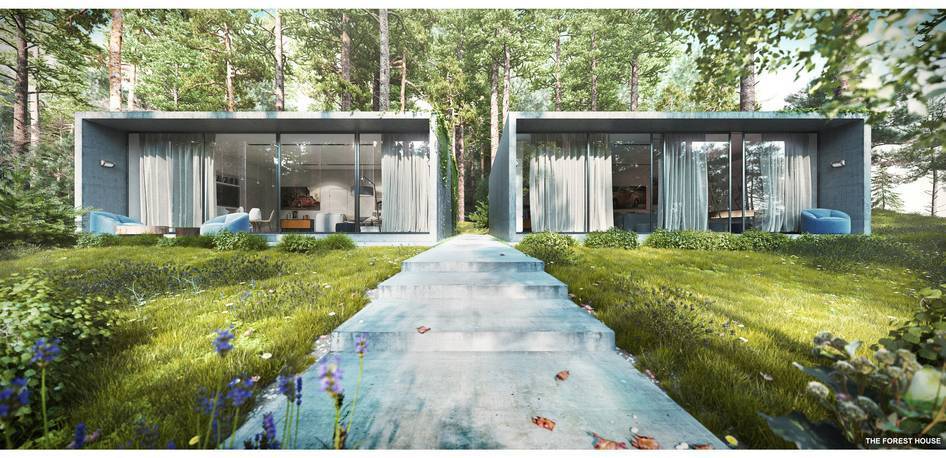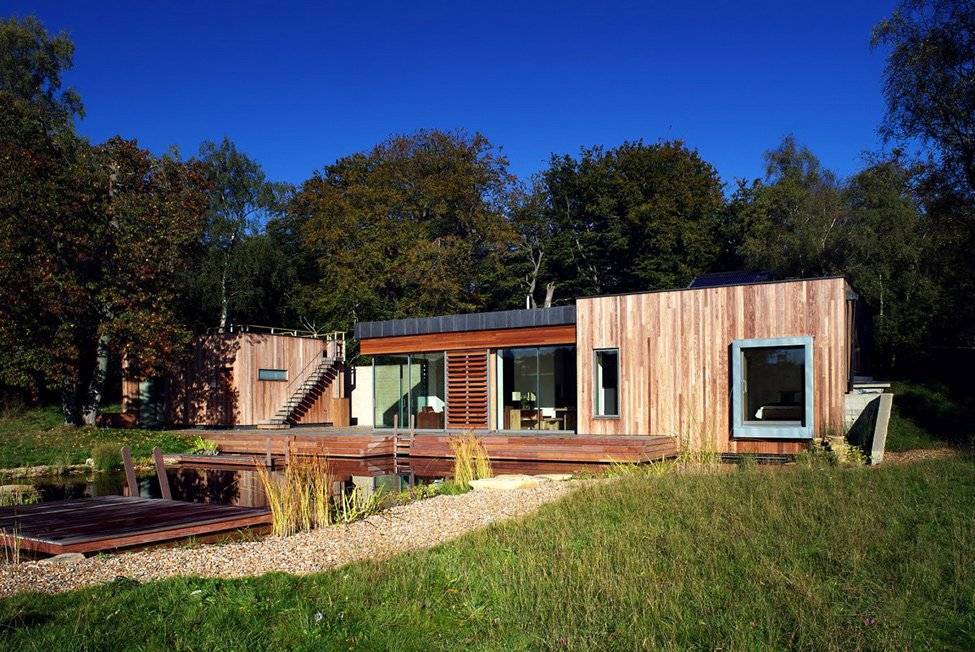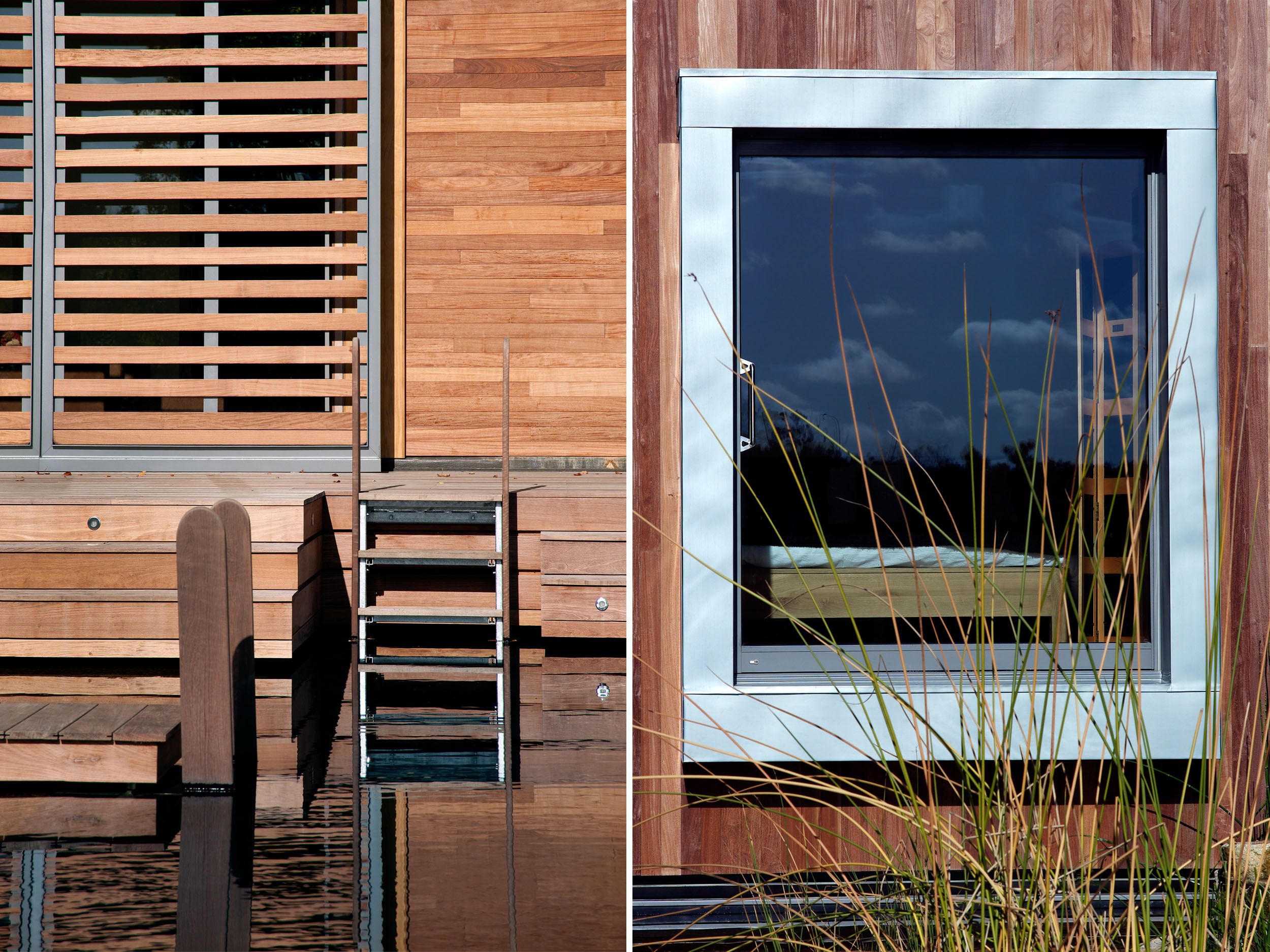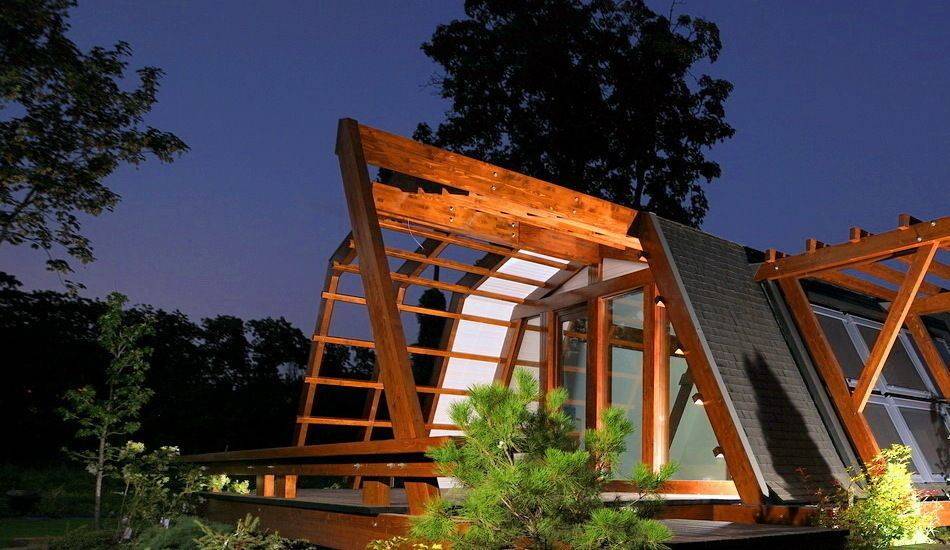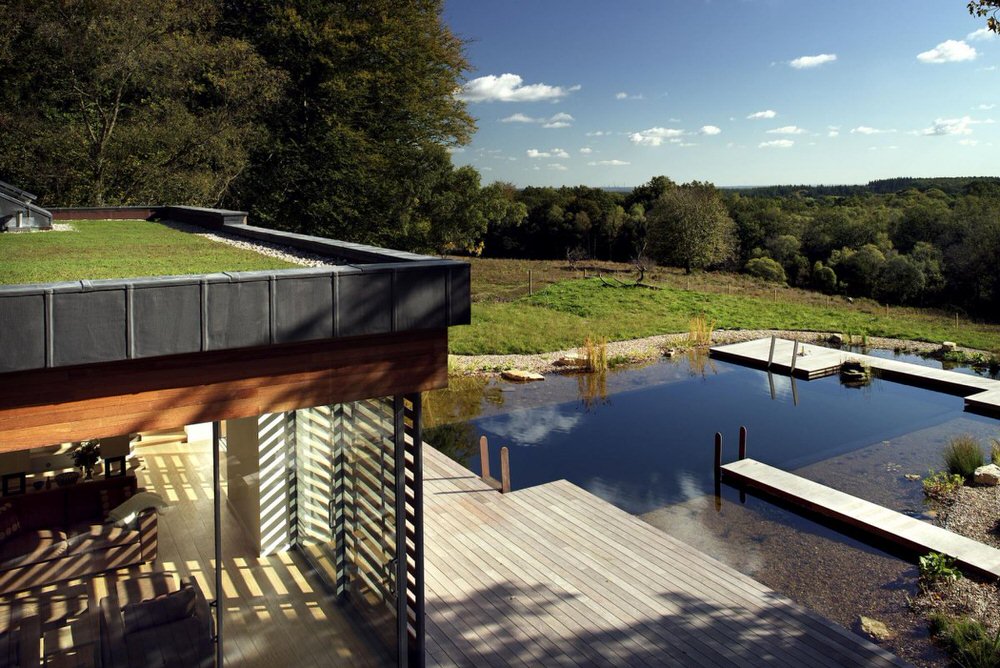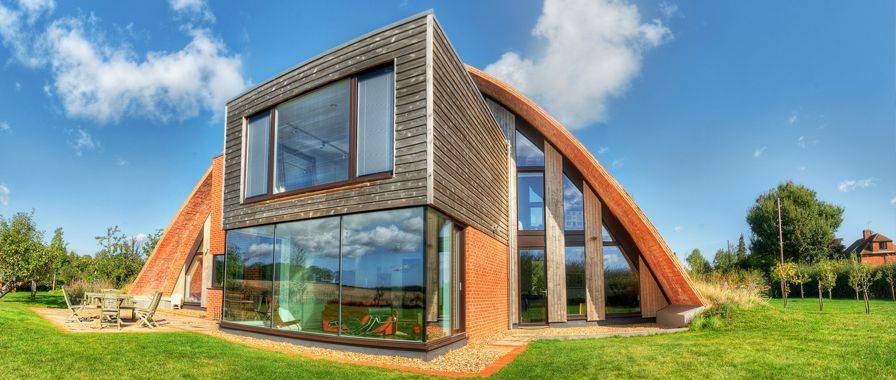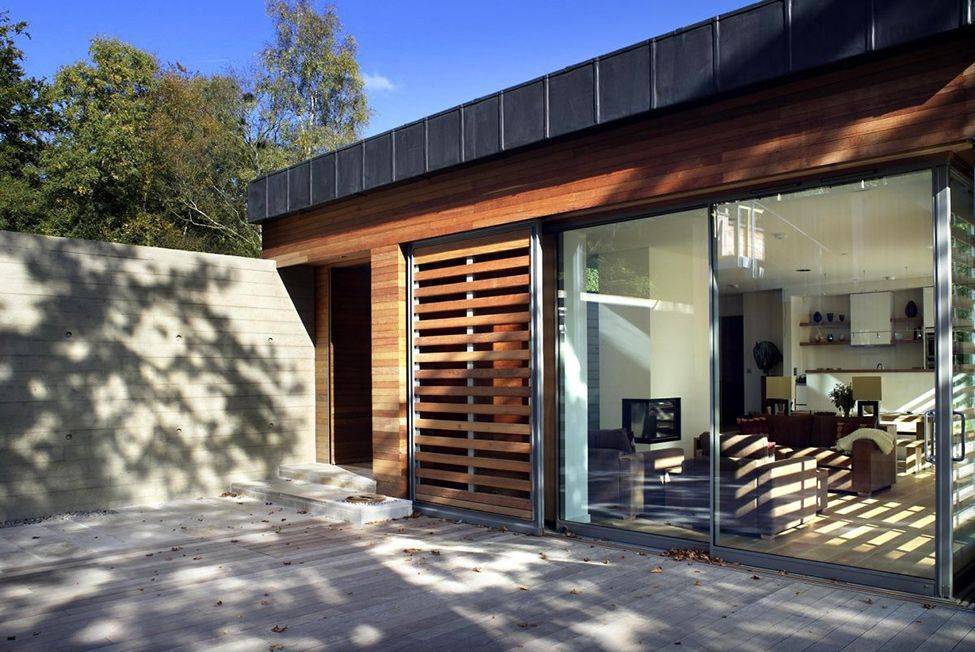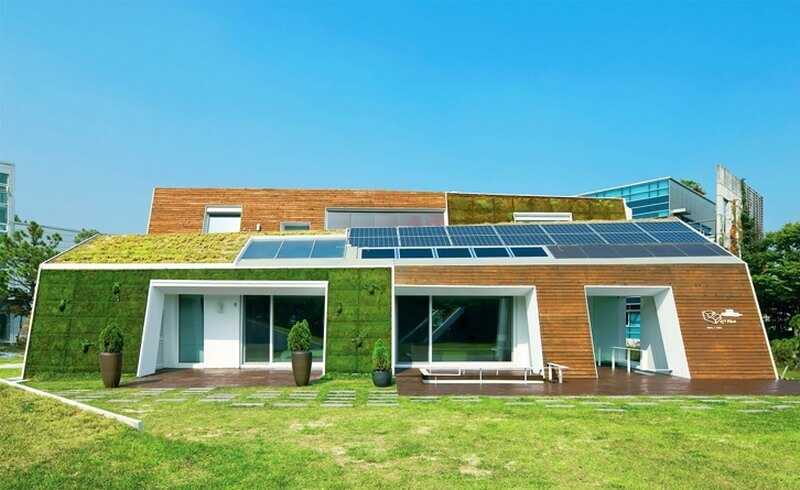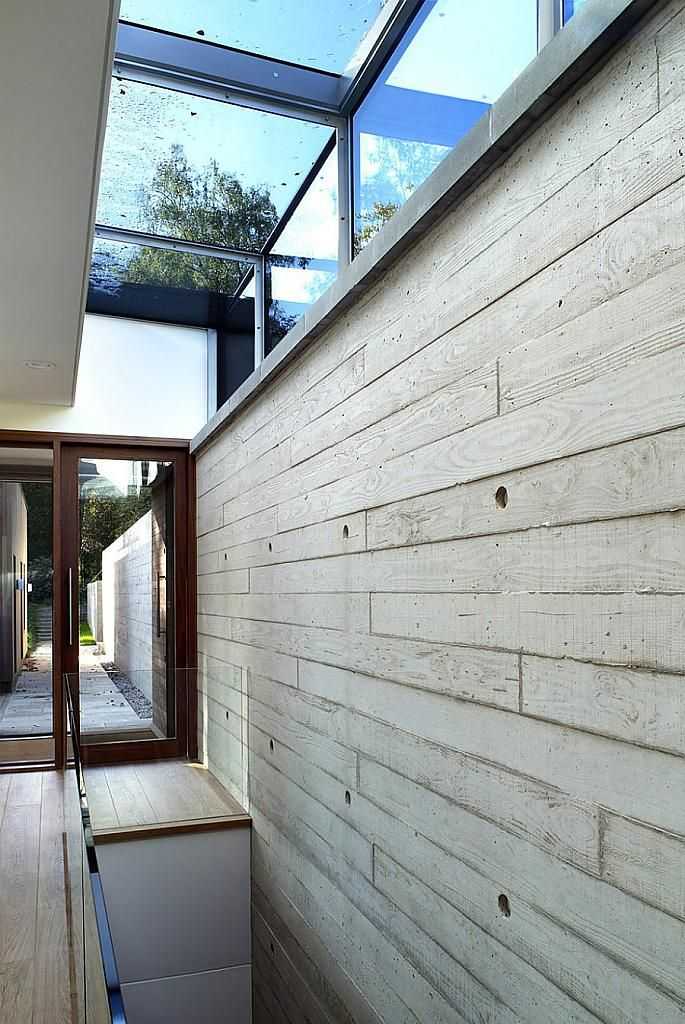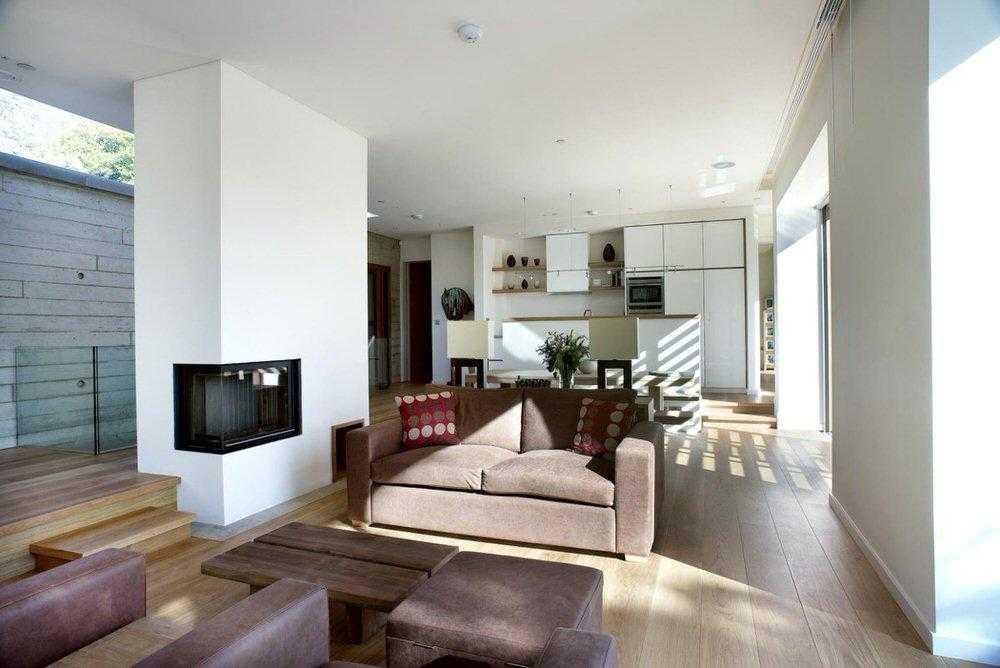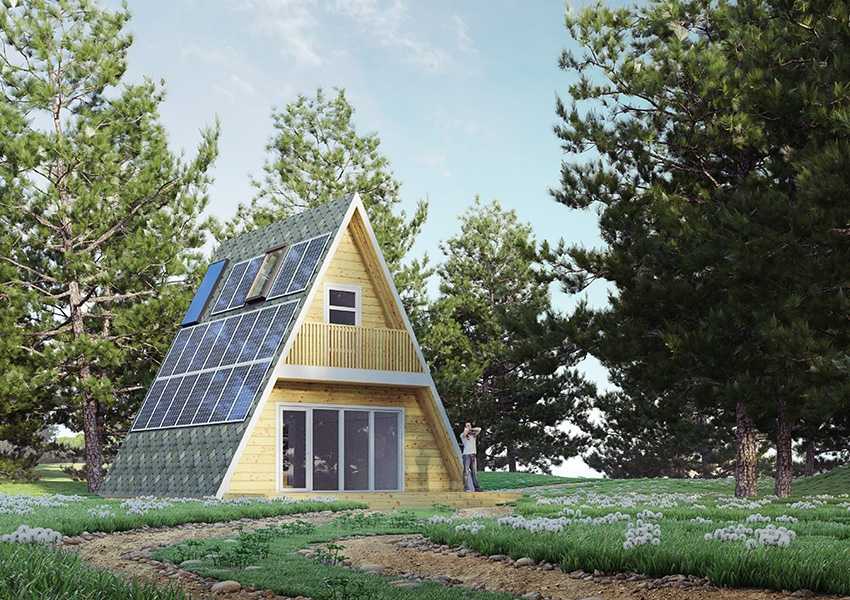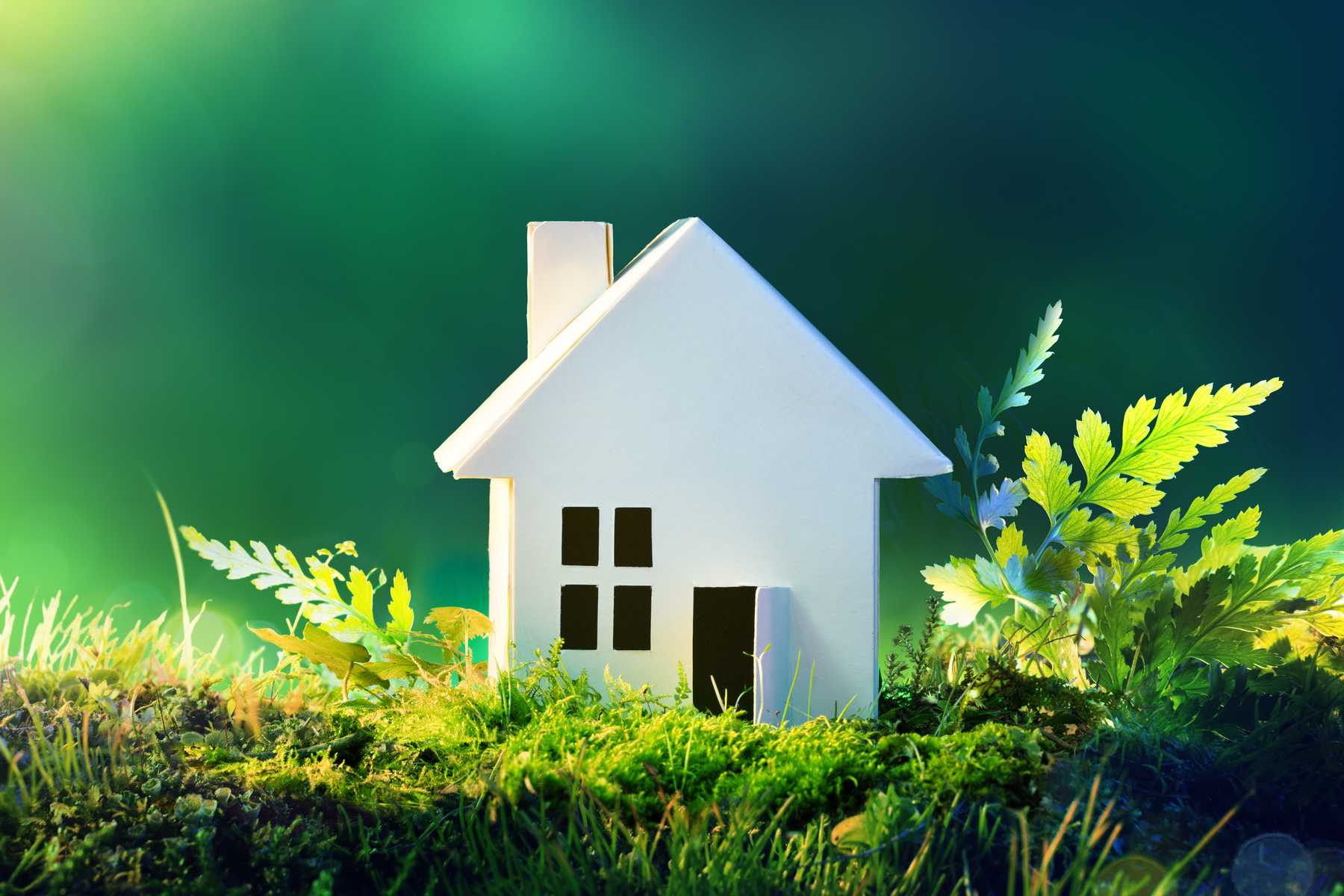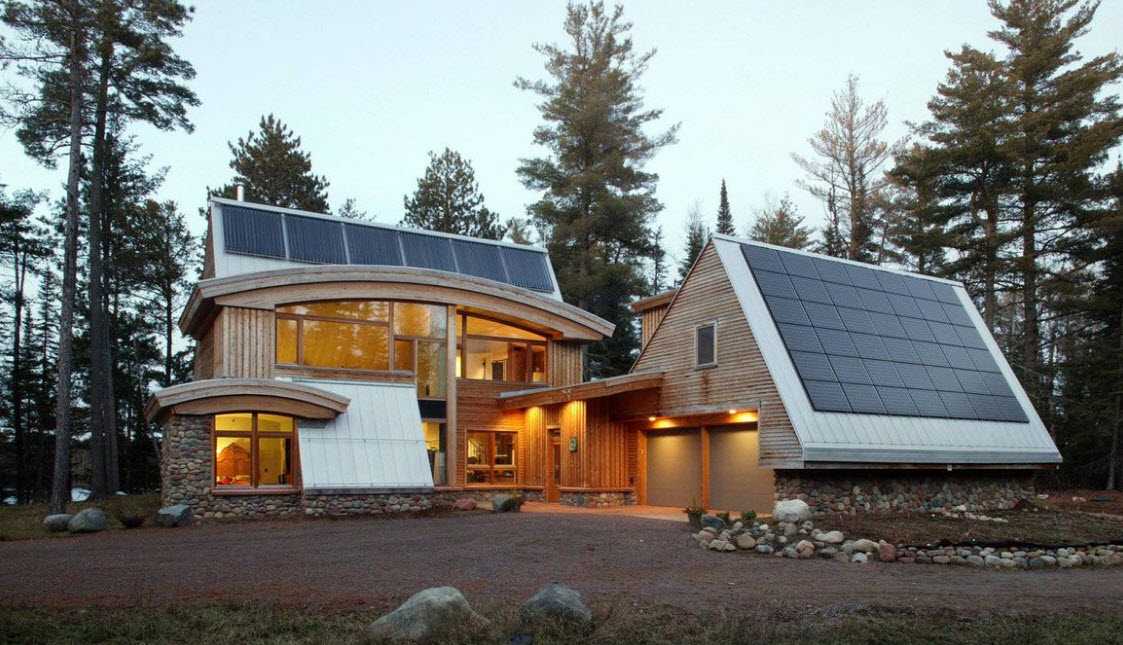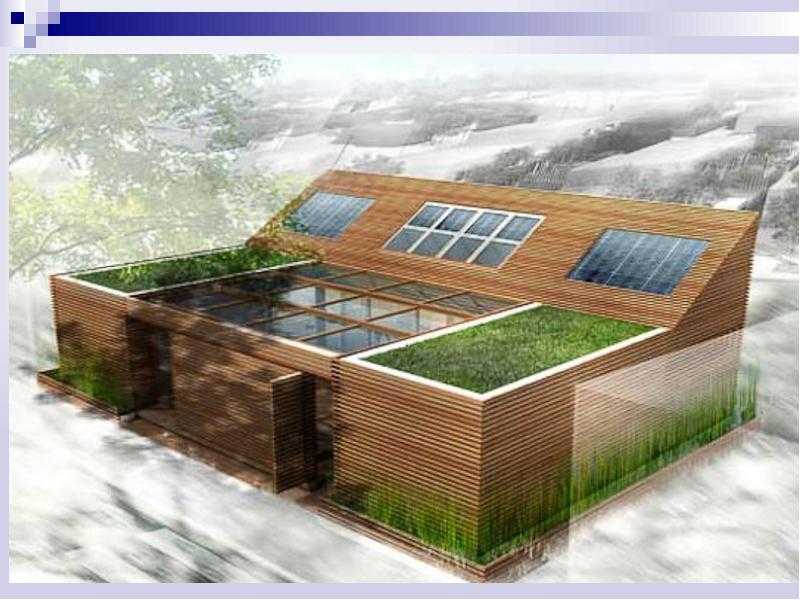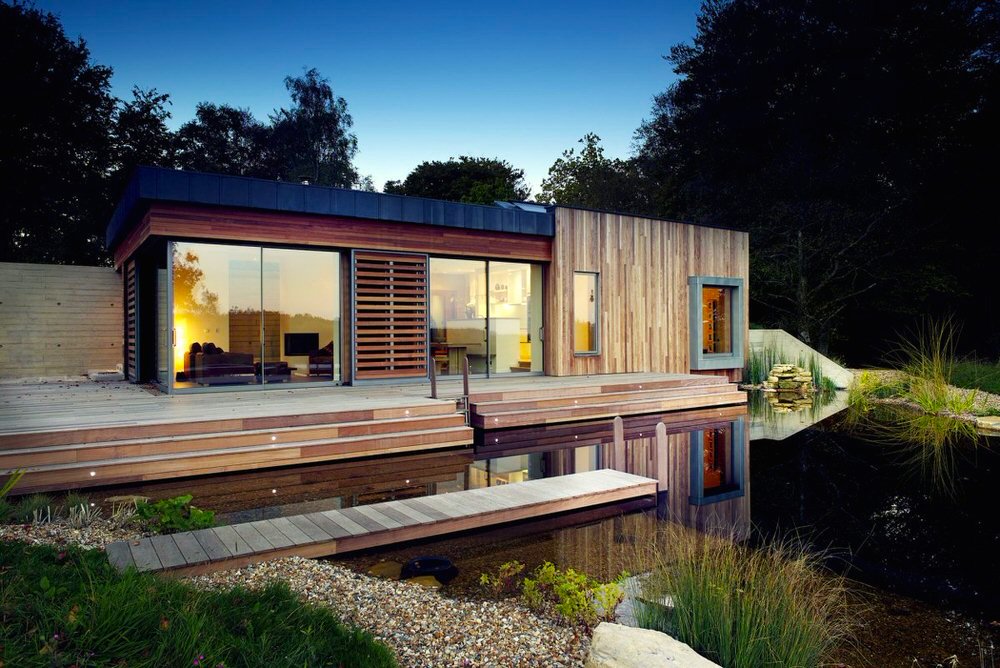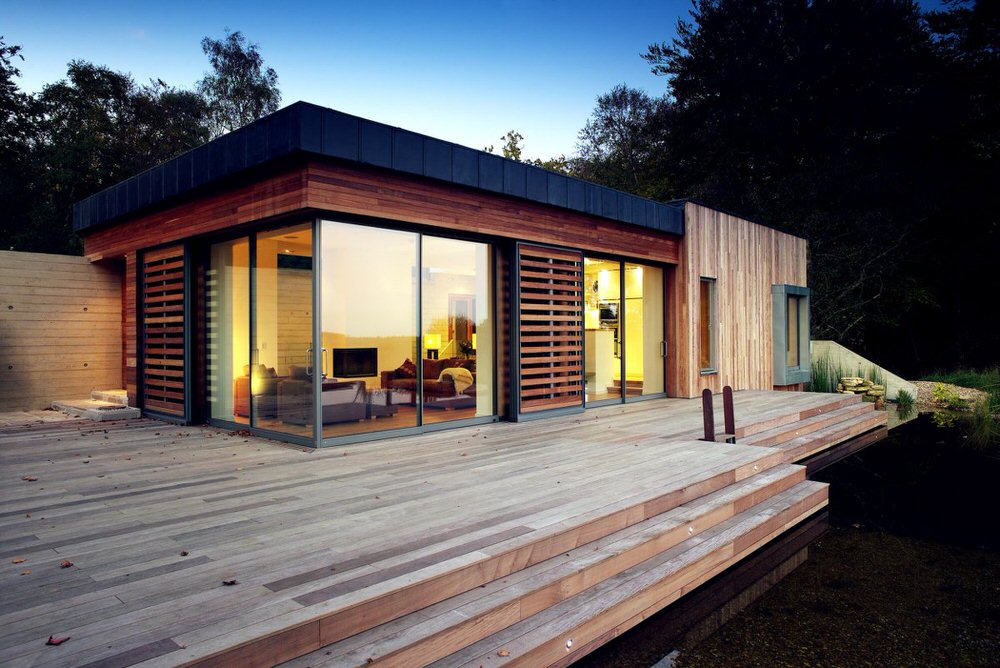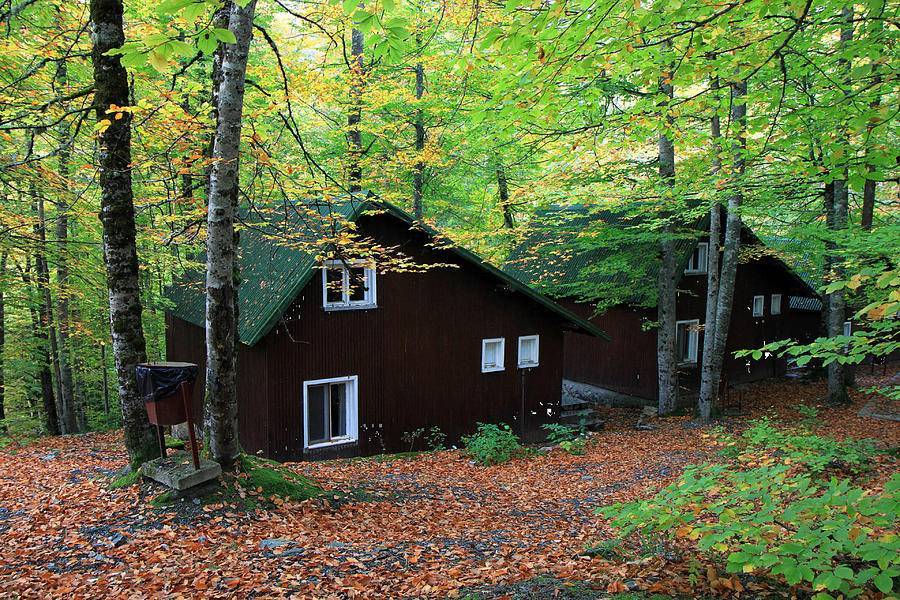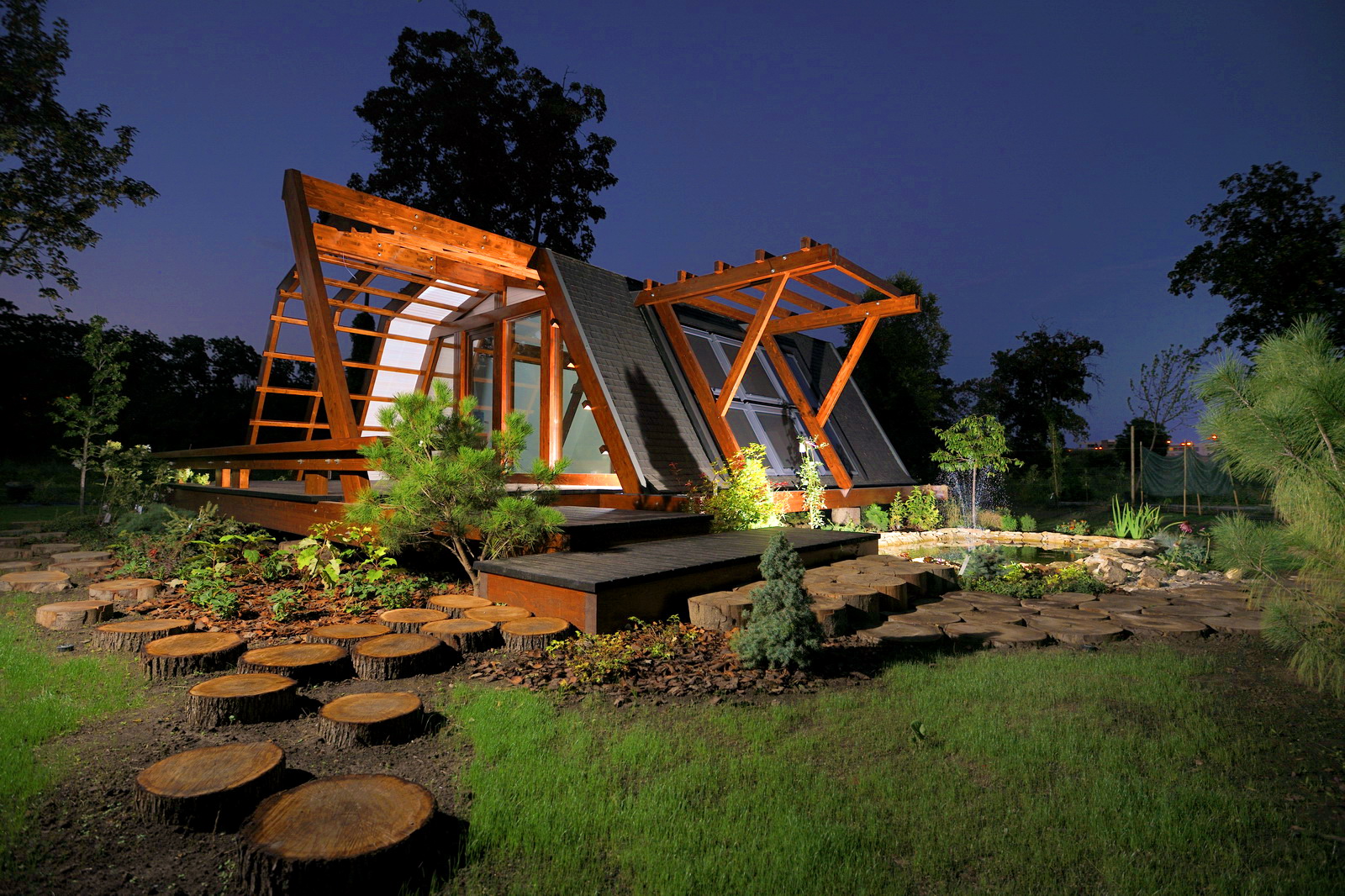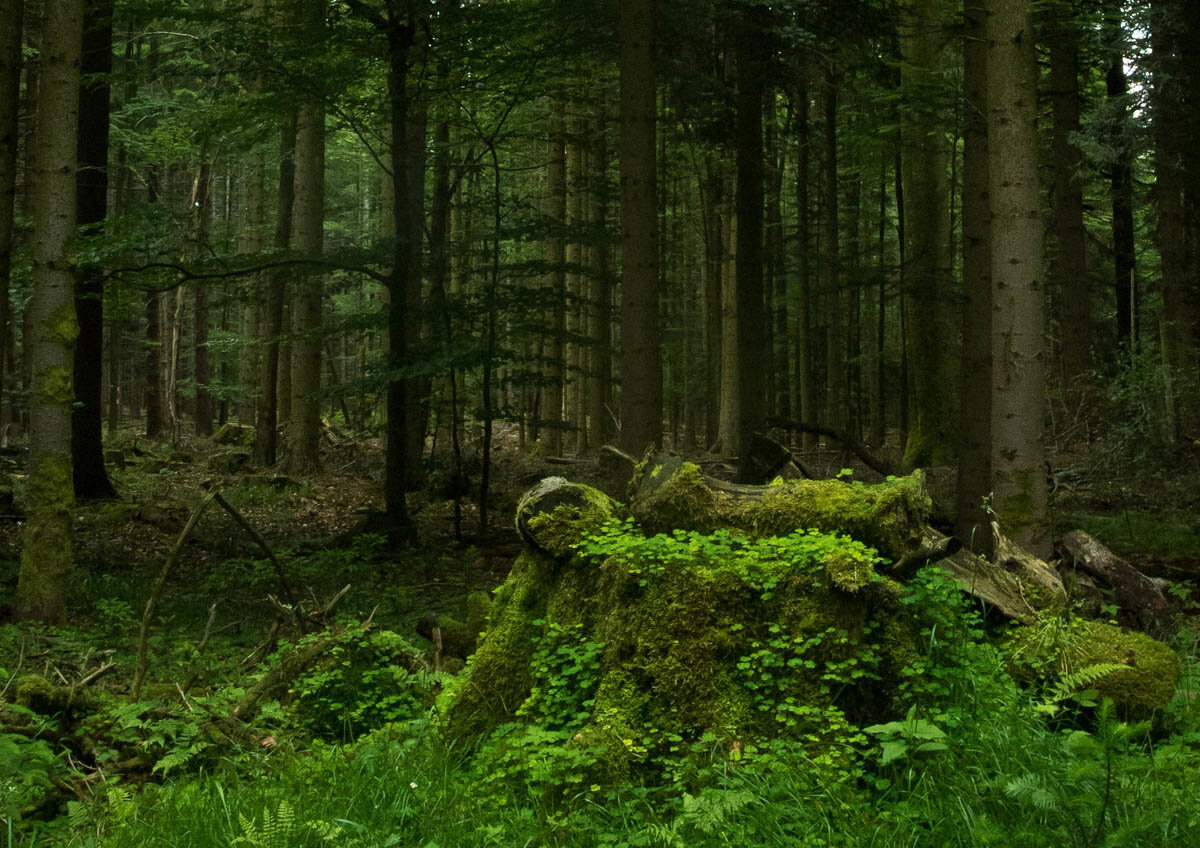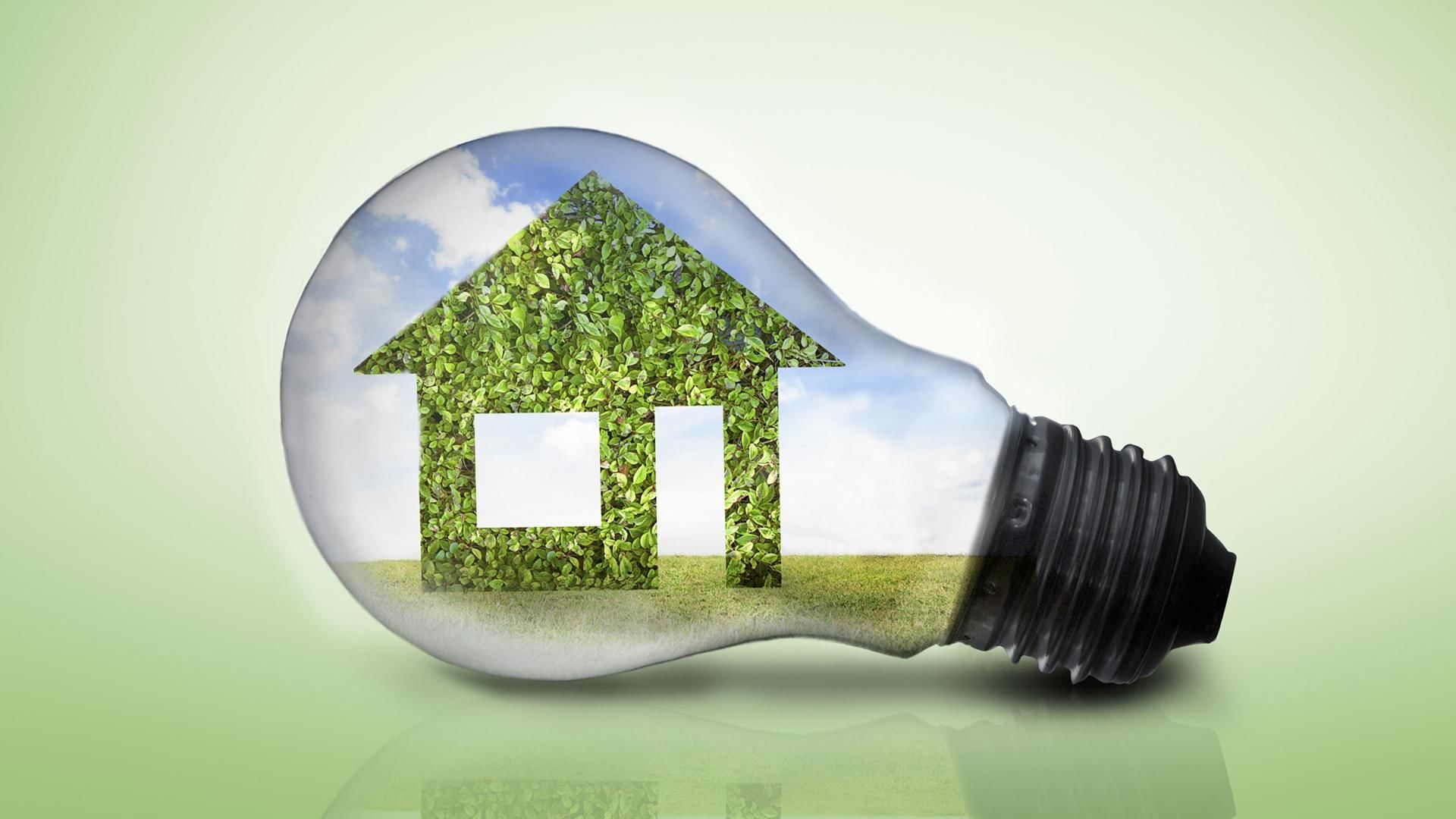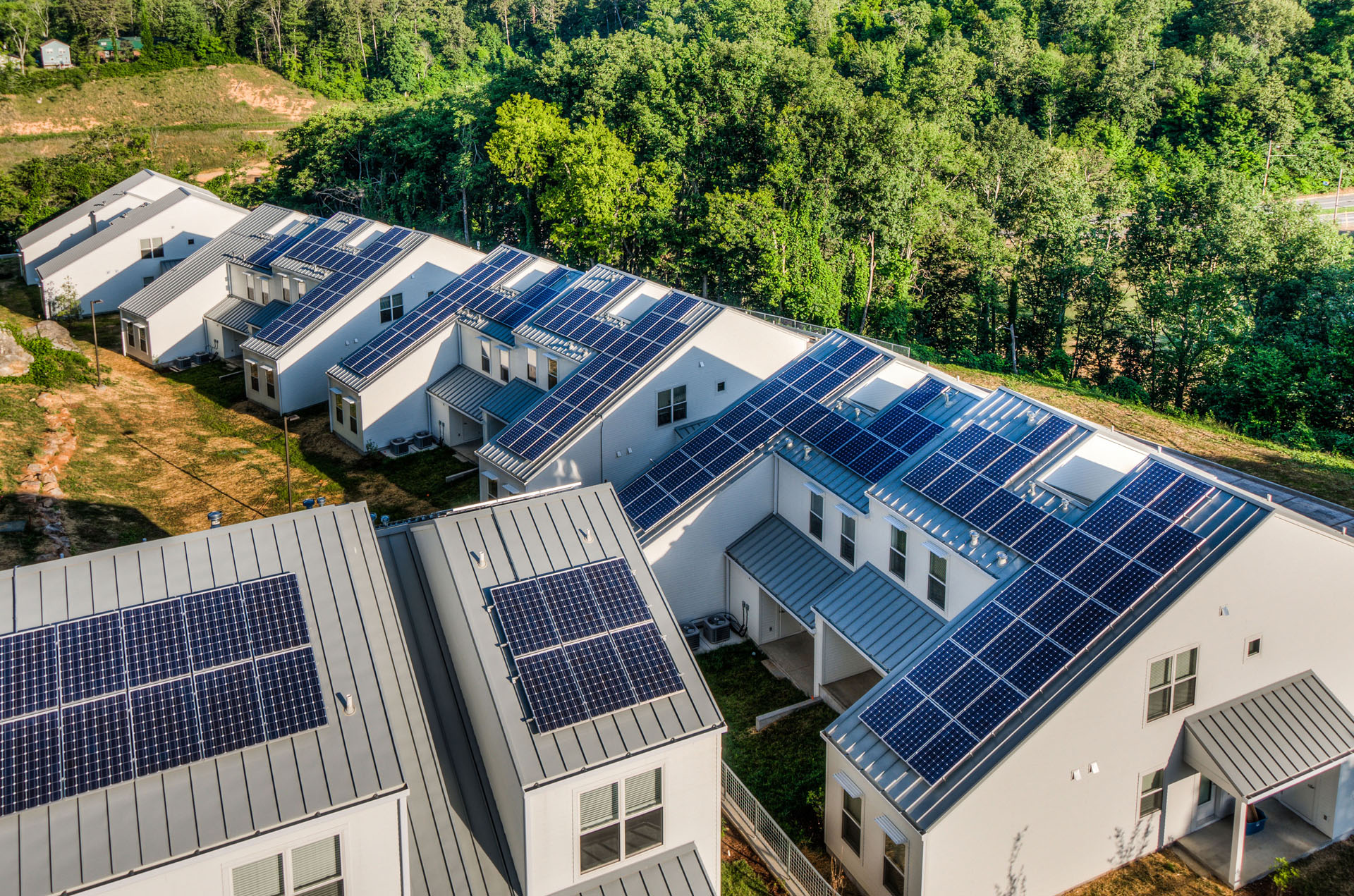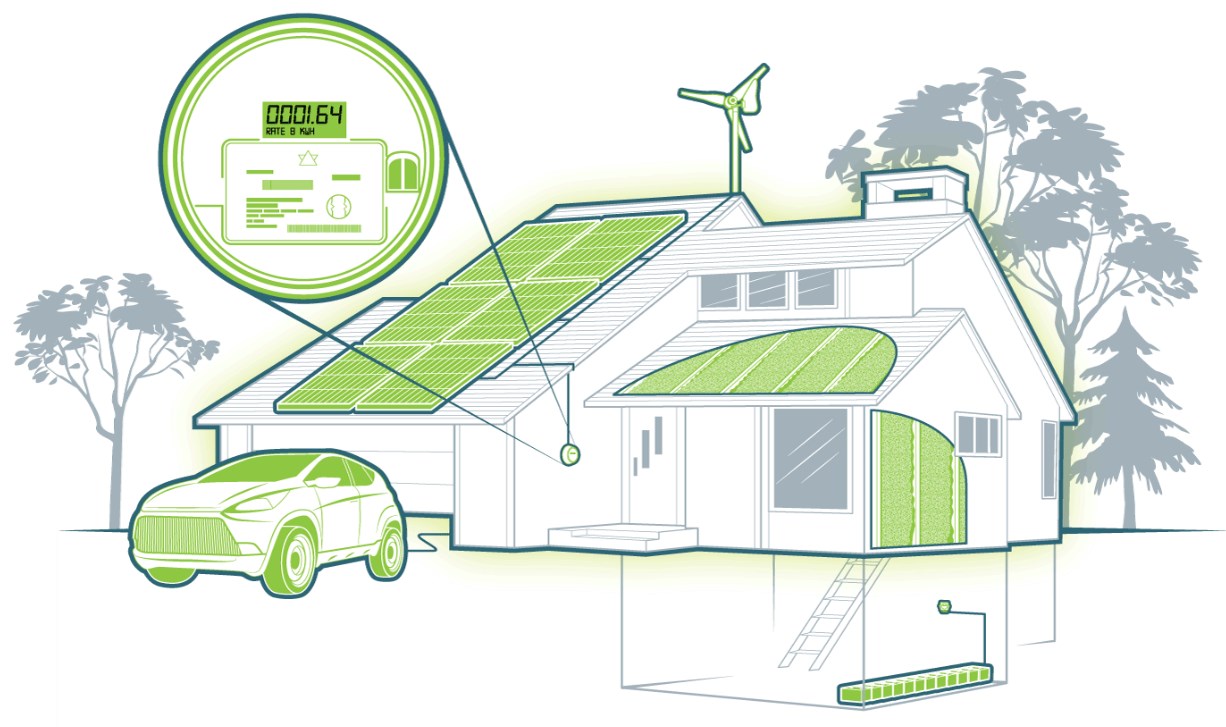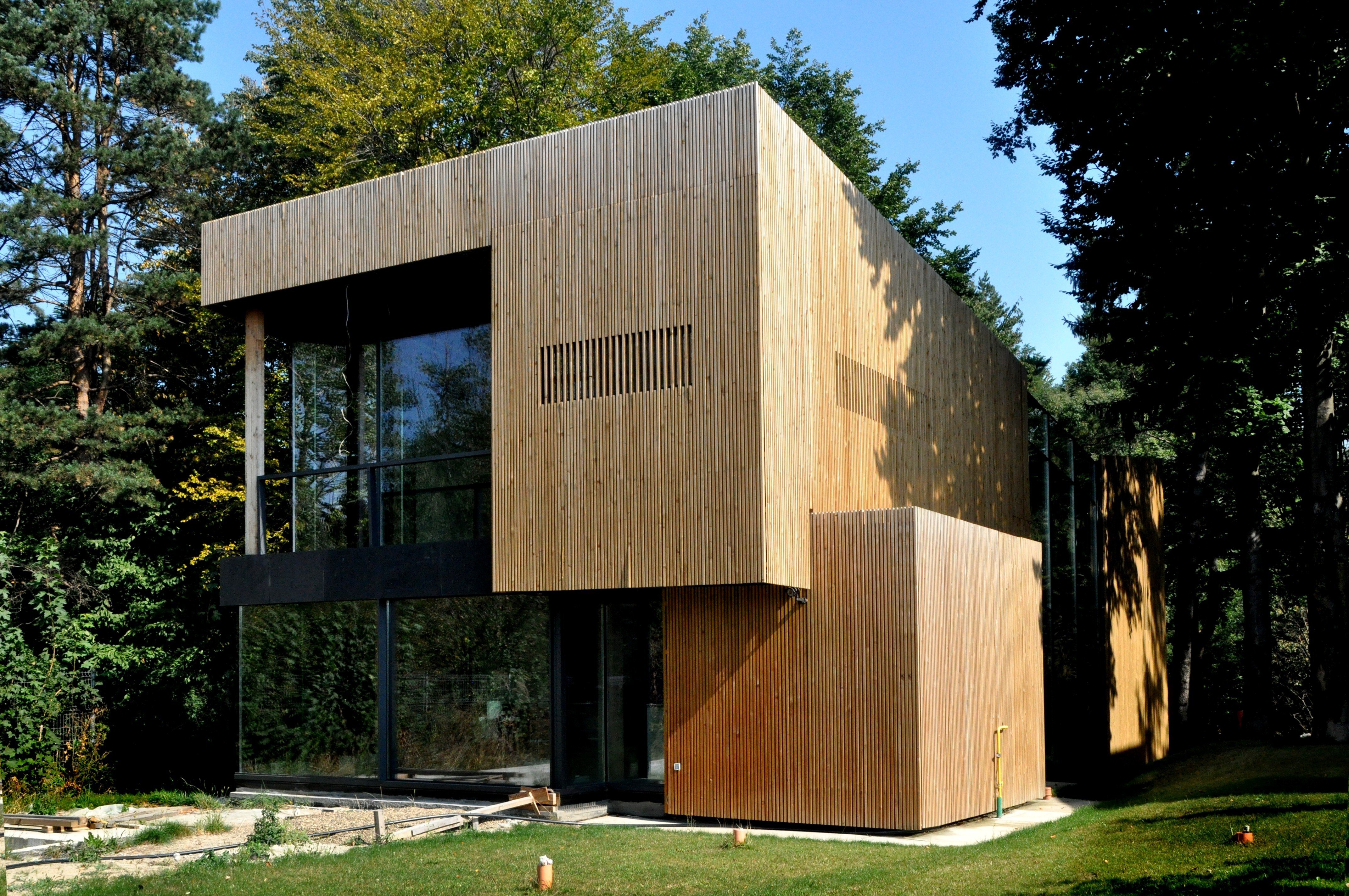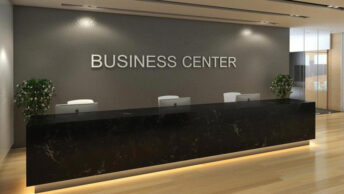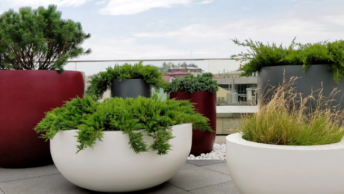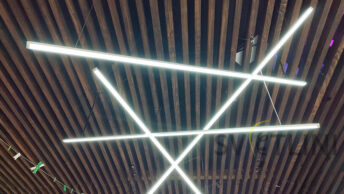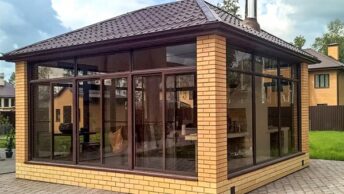Villa of the Star


Located in the Dalat pine forest, Vietnam is a beautiful resort space called Villa of the Star. Design practice APS Concept renovated the space and built the house while focusing on three essential and main factors – connectivity, locality, and sustainability.
Why is it noteworthy?
The unique residence merges perfectly with the forest surrounding it, building a serene human-nature connection. The structure is built using a variety of locally sourced materials, such as stone, pine wood, concrete, steel, and bricks.
What we like
The material that was selected by the design team for the home is ‘modified pine wood’. Modified pine wood is popular for its moisture resistance, mildew resistance, termite resistance, heat resistance, stability, durability, and environmental friendliness
Powerhouse Telemark
Норвегия, архитектурная компания Snøhetta
Powerhouse Telemark — это мини-революция в строительстве. Здание спроектировано так, чтобы произвести больше энергии, чем оно потратит в течение своего жизненного цикла. Это достигается за счет фотоэлектрического купола, закрывающего крышу и южный фасад дома. В результате одиннадцатиэтажное офисное здание способно производить 256 тысяч киловатт электроэнергии в год.
Это в 9 раз больше потребностей самого Powerhouse, так что он может работать как небольшая электростанция для ближайших домов. Кроме того, здание спроектировали так, чтобы оно было максимально энергоэффективным и минимально задействовало электричество для освещения.
Это уже четвертое строение подобного типа, спроектированное и построенное Snøhetta. Идея студии в том, чтобы Powerhouse стал образцом, по которому будут строить дома, адаптированные к условиям климатического кризиса.
BioHome3D


The world’s first 3D-printed home built entirely from bio-based materials such as wood flour or fine sawdust, mixed with a binder made from corn was created by the University of Maine Advanced Structures and Composite Center (ASCC). It is called the BioHome3D, and was specially designed to resolve labor supply chain issues that elevate the costs of homes and reduce the availability of affordable housing.
Why is it noteworthy?
The technology used to build the BioHome3D ensures that the home is primarily manufactured off-site using automation, which leads to less time for off-site3 building and setting up the home.
Энергоэффективность и энергосбережение
Древесина обладает удивительным природным свойством сохранять тепло, что способствует эффективному и менее затратному обогреву дома.
Конечно, поддержание комфортного микроклимата во всех помещениях зависит не только от используемого материала — в ход идут также конструктивные решения и различные виды утеплителя. Так, рубленый фронтон, необходимый для поддержки слеговой системы и кровельного покрытия, отвечает ещё и за надёжную теплоизоляцию мансарды; чистовая подшивка крыши — за защиту теплоизоляционного слоя и теплосбережение, а утеплители — за отсутствие любого возможного продувания пола, стен и крыши. Вместе всё это формирует целостную среду, в которой обогрев всего дома обеспечивается меньшими затратами энергии и средств.
Retrofit for the future
Bere Architects took a ‘build tight, ventilate right’ approach when retrofitting this 232sqm London home for a family of five, reducing the energy required for heating by a whopping 88%.
The upgrade includes new double-glazed sash windows at the front, new triple-glazed windows at the back, and a super-sealed front door by Double Good Windows, plus a high-performance Novus 300 heat recovery ventilation system to keep fresh air flowing inside when the windows are closed. For insulation, Bere used wood fibre for internal walls at the front, and 10cm Permarock phenolic insulationfor the side and back. Amazingly, this created the biggest challenge as they had to win a landmark planning appeal to get permission to add it.
Photo: Jefferson Smith
Здание Вальдесеро, Мадрид
El Здание Вальдесеро, расположенный в Вальдеморо, является первым зданием с почти нулевым потреблением энергии в Испании. Уникальное здание, пионер с точки зрения энергоэффективности, приверженности окружающей среде и речь идет об использовании экологических строительных материалов.
В проекте 27 домов, в здании 8 этажей с 20 парковочными местами и 2 коммерческими помещениями. Дома с 1, 2 и 3 спальнями, а также 3 пентхауса с большими террасами на крыше, с удачной планировкой и современным и элегантным дизайнерским предложением.

Имеет систему внешняя теплоизоляция (САТЭ) и зеленая оболочка, которая улучшает качество воздуха и изоляцию здания в дополнение к сокращению выбросов CO2. Он также имеет активные системы, в которых используются элементы защиты от солнца для эффективного контроля солнечного света. Производится фотоэлектрическая энергия и кондиционирование воздуха Это решается за счет использования аэротермальных систем и полов с подогревом.
Дождевая вода также повторно используется для кровли и орошения. Внутренний воздух постоянно обновляется и снаружи фильтруется. Материалы, использованные при его строительстве они более естественны и без химикатов
New-build clad in sustainable oak
On the outskirts of an Oxfordshire village, this new-build clad in sustainable oak was designed by Peter Feeny Architects to maximise the relationship between architecture and landscape, and to be as environmentally friendly as possible.
A Mechanical Ventilation with Heat Recovery (MVHR) system is supplemented by a wood pellet boiler. Solar heating panels, housed on the garage roof, provide an additional heat source, and photovoltaic panels are located in the garden.
Thermafleece slabs with 85 per cent wool content, fitted within wall and roof cavities, offer insulation, while high-performance, vapour-resistant SIGA sealing tapes used on frame-and-panel joints and abutments within the external walls create a high level of airtightness.
Photo: Peter Feeny
Renewable, low-carbon constructed home
Hillside, nestled in the Kent Downs, is a modern approach to a traditional agricultural building, designed by Derek Rankin of RXArchitects for Simon Pack of Coast Pro Developments. Clad almost entirely in renewable cedar shingles, its large areas of glazing were positioned to limit unwanted heat gain and keep the internal spaces airy with cross-ventilation.
The super-structure, formed from a Kingspan-insulated timber frame system, was prefabricated off-site; factory-fitting the insulation reduced waste and it achieves high levels of thermal performance. A recyclable insulated beam-and-block substructure was used in place of a mass concrete-poured slab.
The low-carbon construction, combined with passive solar design, an air source heat pump and photovoltaic panels, ensures the build is highly sustainable and comfortable – Simon doesn’t need to turn on the heating and only occasionally lights the wood-burning stove.
Photo: Sawdust
McGee’s Tiny Home


This lovely little home is located at the bottom of a rocky hillside and is surrounded by cypress trees and buchus. The tiny wooden cabin overlooks the Muizenberg, one of Cape Town’s best-known surfing spots, and occupies 390-square-foot of space.
Why is it noteworthy?
The stunning view can be enjoyed owing to the windows seat that has been added to the space. It was designed by architect Alexander McGee and is located next to his South African home.
What we like
No gutters have been added to the roof, and this allows McGee and his family to watch the rainwater run off the roof from different angles
The New Forest House


PAD studio has been conducting a study on the New Forest House in the New Forest National Park for the past 10 years. It has been looking into the true environmental impact of low-energy homes.
Why is it noteworthy?
The building was carefully constructed to ensure that minimal disturbance was caused to the surrounding site, as well as the site’s sensitive landscape. The residence features the main house and a guest annex.
What we like
- The New Forest House is a 97% less expensive house to run as compared to a house built in accordance with 2021 building standards
- The house utilizes 110% less energy as compared to a home powered by gas
Adraga


Called Adraga, the tiny home features an array of sustainability elements including solar panels, rainwater collection, and composting garden beds. As part of a larger series of tiny home on wheels, Adraga is home to a retired couple who just want to disconnect from the busyness of the world.
Why is it noteworthy?
Looking at Adraga from the outside, its unstained pinewood facades invoke simplicity. Defined by a rectangular, flat-roofed silhouette, the team at Madeiguincho found movement through windows and doors. On one end of the tiny home, a single, farmhouse-style door welcomes residents into the home’s subdued bathroom. There, against the soothing backdrop of walnut wood panels, residents can enjoy a semi-outdoor shower atop wooden floor slats.
What we dislike
In the bathroom, a dry toilet operates without flush water and closes the waste loop – but not everyone may be comfortable with using it
The Water Cabin


The Water Cabin is a floating home in Seattle’s Portage Bay that maintains the houseboat’s classic nautical personality and the weathered coziness of a cabin.
Why is it noteworthy?
Defined by a geometric silhouette that exhibits Kundig’s classic style, the Water Cabin’s frame is supported by galvanized steel structures that cradle spacious roof planes and wooden decks. Building the Water Cabin, Olson Kundig and their client hoped to blend interior and exterior spaces throughout the home. Arranged over two levels, the home’s interior spaces are specifically configured to maximize connections to the marine environment.
What we like
- Russian birch plywood ceilings line each room overhead, capturing the natural sunlight of the day and brightening the home
- Large roof overhangs protect the patio’s wood from seasonal elements
Halfmoon Bay Cabin


Designed by Patrick Warren and his husband Kevin Kaufman, this angular black cabin is called the Halfmoon Bay Cabin and is tucked away on the Sunshine Coast of British Columbia. The cabin is nestled away between trees and gracefully merges into the landscape.
Why is it noteworthy?
The home is defined by a covered entry, spacious living space, a steeply sloping roof, and massive floor-to-ceiling windows that create a connection between the indoors and the outdoors.
What we like
The beautiful home is inspired by American coastal architecture of the 1970s, like those found on Fire Island in New York and Sea Ranch in Northern California
Multiple eco technology
Not only is the wood used to clad this home sourced from local, sustainable forestry’s, meaning it has a low carbon footprint, it also acts as a carbon sink.
The property also includes several forward thinking eco-friendly technologies, including a mechanical ventilation heat recovery (MVHR) system that provides fresh air and regulates temperatures, as well as solar panels and an air-source heat pump.
The orientation of the house, and the layout and shape of the glazing make use of both the solar gain potential, and the south westerly views. The metal profile roof is an efficient, readily available material with many references locally in agricultural buildings.
Photo: Makar
Additional words: Lucy Searle and Hugh Metcalf
READ MORE
- 10 tips for designing your eco home
- Create your dream eco home with modern post and beam
- Small plot eco homes in south London
Heart of glass
If Mies van der Rohe was alive today, he might have built something like this German home by Werner Sobek. It bears a striking similarity to van der Rohe’s 1951 Farnsworth House, but without any of the overheating or condensation that mired the masterpiece.
In fact, you’d be hard pushed to find a better-performing building. It’s wrapped in high performance argon-filled triple glazing and has wide overhangs to shield the interior from the harshest summer sun. Heating is provided by a ground-source heat pump, and the roof is entirely covered in photovoltaic panels. The 230sqm house, constructed in 2011, includes a basement and cost around €450,000 (approx £372,000).
This Werner Sobek build bears a striking similarity to van der Rohe’s 1951 Farnsworth House. Photo: Zooey Braun
Eco-friendly period cottage
The facade of this cottage, nestled in the Lyth Valley of the Lake District, is the only original element of the building. Behind it is an eco-friendly new-build designed by Ben Cunliffe Architects, which worked closely with the Lake District National Park Authority.
During the course of the works the roof was replaced and two of the four external walls were taken down and rebuilt. New floors allowed for underfloor heating powered by a ground source heat pump and borehole technology, while the new roof improved headroom and assisted with the alteration of the layout.
The building is super-insulated throughout and the highest quality windows were installed. A sedum roof adds to the insulation and reduces surface water run-off. Local materials were used where possible, including Burlington Slate on the cottage roof and local stone cladding.
Photo: Ben Cunliffe Architects
Hello Wood piles leafy boxes for the Garden of Communities
Budapest-based design studio Hello Wood has completed a public installation that utilizes the interplay of geometric forms and abundant greenery to create intricate shapes. Located at the heart of the Factory’ard in Veszprém, their latest creation, The Garden of Communities, serves as a tribute to the vibrant culture of the Veszprém-Balaton region. By stacking leafy wooden boxes in a spiral manner, the pavilion stands as a symbolic monument, symbolizing the collaborative efforts of the 116 municipalities involved in the Veszprém-Balaton 2023 European Capital of Culture programme.
It is not the first time that Hello Wood has created a public work that represents an important purpose. Among their most iconic creations were the Sledge Trees shaped like Christmas trees (see more here and here), which adorned several European cities on a temporary basis before being dismantled, and the sleds donated to charitable causes.
‘For each municipality participating in the VEB 2023 programme, we have designed a unique planter box, with the name of the municipality clearly displayed on the side, containing a sapling. In Veszprém, which is the central site of the European Capital of Culture 2023, we have set up a Garden of Communities, consisting of 116 planters, which promotes the eternal values of community cooperation,’ explained Balázs Szelecsényi, the project’s architect.
all images by György Palkó Hello Wood
Муниципальное жилье Passivhaus
Великобритания, архитектурное бюро Mikhail Riches
Фото: Mikhail Riches
Это не один, а целых 600 домов, которые должны быть построены в Йорке. Предполагается, что дома будут углеродно-нейтральными в эксплуатации за счет энергоэффективного строительства и использования возобновляемых источников энергии. Также к кварталу подведут ветки общественного транспорта. А в дворах и на крышах можно будет разбить небольшие «огороды».
Проектом занимается бюро Mikhail Riches по заказу администрации города. Помимо экологичности, одним из очевидных плюсов таких домов должны стать низкие счета за коммунальные услуги.
Дом между Энсинасом, Астурия
Этот дом сочетает в себе концепции энергоэффективности пассивного дома с использованием материалов и строительных систем с низким воздействием на окружающую среду. Для его строительства была изучена естественная радиоактивность окружающей среды., очень низкий при нахождении на известняковой местности, и геобиологическое исследование было проведено на месте, чтобы определить местонахождение остальных участков.
Все материалы были выбраны по биоконструктивным критериям, в основном из органического происхождения, на 100% возобновляемого, например, из перекрестно-ламинированной древесины для конструкции; пробковый утеплитель для фасада и крыши; изоляция из пеностекла под плитой; полипропиленовые трубы, электромонтажные и электротехнические материалы; биосовместимая электрическая установка; известковые штукатурки на фасаде
Он также уделяет приоритетное внимание использованию солнечной энергии и повторное использование дождевая вода для туалетов, стиральных машин и полива

Algonquin Highlands Cottage


Located on an island peninsula in the lake of Algonquin Highlands is an idyllic wooden cottage built by BLDG Workshop. The lovely cottage has a view of the rocky outcrops and shorelines of the Great Canadian Shield and makes for a picturesque getaway location.
Why is it noteworthy?
The cottage was constructed while paying special attention to the relationship between indoor and outdoor space, and the natural landscape of Ontario. The natural elements of the site were amplified and elevated – for example, the sun patterns on the peninsula since they are related to the morning and evening light.
What we like
The studio incorporated a large indoor-outdoor space at the front peak of the home, which overlooks the lake and the stunning landscape
a blend of geometric forms and lush greenery
Stacked on top of each other, the triangular planters form a circular exhibition space accessible to anyone. The juxtaposition of voids, solids, and abundant greenery produces a magical kaleidoscope-like view skywards, drawing in visitors who can freely explore the pavilion and reflect upon the names of villages or cities that hold cherished memories for them.
By planting native tree saplings within containers, the team at Hello Wood sought to form a biodiverse vertical garden that flourishes and gains resilience as the seasons progress. The structures are equipped with an automated irrigation system that guarantees consistent growth of vegetation. Moreover, the intricate design of the installation offers varied sun exposure, wind patterns, and rainfall conditions, allowing each tree species to be positioned appropriately based on their specific water and sunlight needs.
each container reflects the names of villages or cities that might hold cherished memories for the visitors who know those regions
The historical significance of the site, which was home to one of the largest furniture factories in the region for some 120 years, was also a key factor in the design. To honor this historical heritage, the planter boxes are adorned with cladding crafted from reclaimed timber sourced from the Drechsler Palace in Budapest, featuring old larch planking that dates back almost 120 years. By incorporating these antique materials, the installation not only pays homage to the past but also adds a timeless quality to the work, enhancing its historical reference even further.
After four years, each planter will be returned to its corresponding municipality. The saplings planted within them will continue to thrive and transform into trees, serving as enduring symbols of the unity achieved in 2023. As part of the VEB 2023 programme, the Hello Wood architectural summer school and festival will make a comeback from the 6th to the 15th of July. This time, the event will take place in the basalt mine of Zalahaláp, providing an inspiring new setting for participants and attendees alike.
geometric architectural forms and abundant greenery produces a magical kaleidoscope-like view skywards
Self-sufficient Forest Lodge
Forest Lodge is a home with a difference: it is mobile and was built to comply with the Caravan Sites Act 1968. The owners, who had been living in a static caravan for 15 years on their stunning plot in the New Forest, approached Ricky Evans at PAD studio to design a low-energy building with a strong connection to the landscape.
Importantly, it wasn’t meant to feel like a mobile home. For a build cost of £300,000, Evans came up with a prefabricated, chestnut-clad design with large amounts of glazing that exceeded the owners’ low-energy aspirations.
It meets the rigorous Passivhaus standard and is essentially self-sufficient, thanks to photovoltaic panels on the roof that generate electricity, and an air source heat pump, which provides hot water for an underfloor heating system.
A sewage treatment plant manages waste and rainwater, collected in an underground storage tank for watering the garden.
Photo: Pad Studio
Salute to the sun
This house in Melbourne, Australia, has turned its back on the bad to embrace the good. Its south-facing rear (equivalent of north-facing in the northern hemisphere) was casting shadows across the garden, and surrounded by ugly buildings on all sides, so Melbourne practice Architecture Architecture designed a clever extension across the back.
It has allowed the owners to relocate their living-dining-kitchen space to face north, so they get good natural light all day, and also includes a private courtyard garden that blocks out the unsightly neighbouring properties. A tall roof allows room for clerestory windows, which bring in more light and ventilation. Dark concrete floors also soak up warmth from the sun and release it later. The extension has added approximately 30sqm of space.
Photo: Tom Ross of brilliantcreek.com
Find Sanctuary


Designed by Charlie Hammon, the Find Sanctuary is designed to provide some peace of mind and a safe space for frazzled workers. The cozy and lovely home serves as an oasis for overworked employees who need some downtime, and space to unwind.
Why is it noteworthy?
Hammond then brought to life his idea, ‘Find Sanctuary’. Find Sanctuary is a renewed and revamped version of remote working. It includes a collection of 40 tiny cabins in Big Bear, California that can be rented, providing exhausted employees with an opportunity to work in a peaceful environment and regain some of their composure.
What we like
- Amped with stunning views of the surrounding mountains
- The wooden cabin has been equipped with high-speed WiFi, and a built-in desk with a stunning view as well, to make your workday efficient and serene
Pop-up house
A prefabricated property that complies with Passivhaus standards and can be assembled with just a screwdriver? You’re looking at it. This prototype pop-up house by French company Multipod Studios is built with lightweight expanded polystyrene insulating blocks, separated by laminated veneer lumber boards to create an airtight structure that requires almost no additional heating.
The main structure was assembled in just four days, and the rest of the house in another three weeks. Multipod Studios says other types of insulation boards can also be used, such as rockwool. The concept could be available to the public in a year, and the prototype cost €200 (approx £165) per sqm.
Photo: Multipod Studios/Elisabeth Montagnier
Pad Studio создает сборное жилье в соответствии с правилами жилищного строительства New Forest
Этот обшитый каштаном дом Pad Studio был изготовлен за пределами завода, а затем переброшен на поляну в Нью-Форест, на участок защищенного леса в английском графстве Хэмпшир (+ слайд-шоу).
Клиенты жили в статическом караване на участке в пять акров в течение 15 лет, но обратились к местной практике по обновлению своего дома.
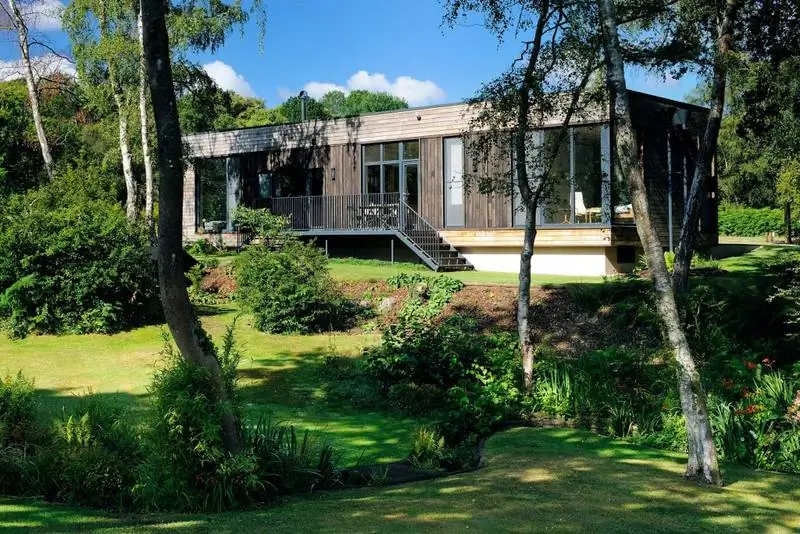 Image
Image
В результате получается скромная, обшитая деревом хижина под названием Forest Lodge, которая технически все еще считается караваном.
«Ключевым требованием их задания было создание нового дома с очень низким потреблением энергии, залитого светом и имеющего прочную связь с окружающим ландшафтом», – сказала управляющий директор Венди Перринг.
«Важно отметить, что новое жилье не должно напоминать или чувствовать себя как дом на колесах». Image
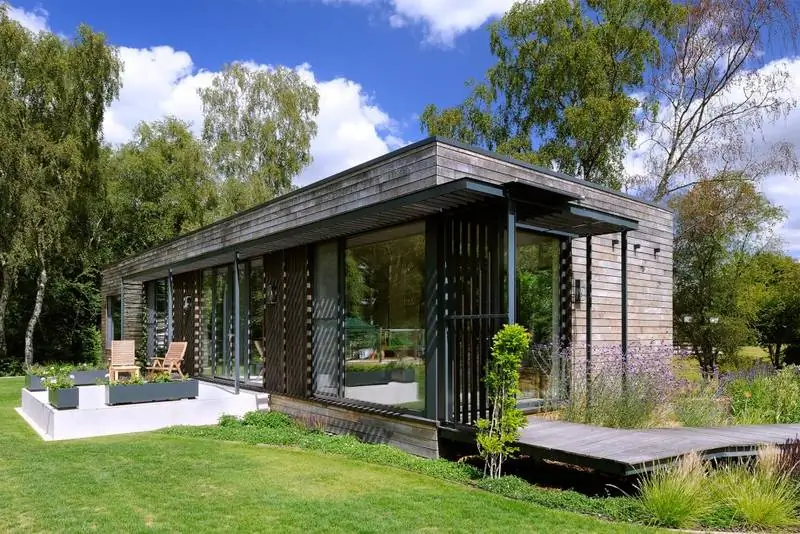 Image
Image
Сайт пришел с строгим контролем планирования из-за статуса национального парка Нью-Форест. Эти правила направлены на предотвращение повреждения 200 квадратных миль пастбищ, лесов и пустошей, которые обеспечивают среду обитания для его знаменитой колонии пони.
 Image
Image
Здание должно было соответствовать Акту о караванах 1968 года, ограничивая его длину до 20 метров, а ширину – до семи метров.
Конструкция была изготовлена на заводе в Йоркшире и установлена на две отдельные части. Это означает, что он также может быть удален таким же образом позднее.
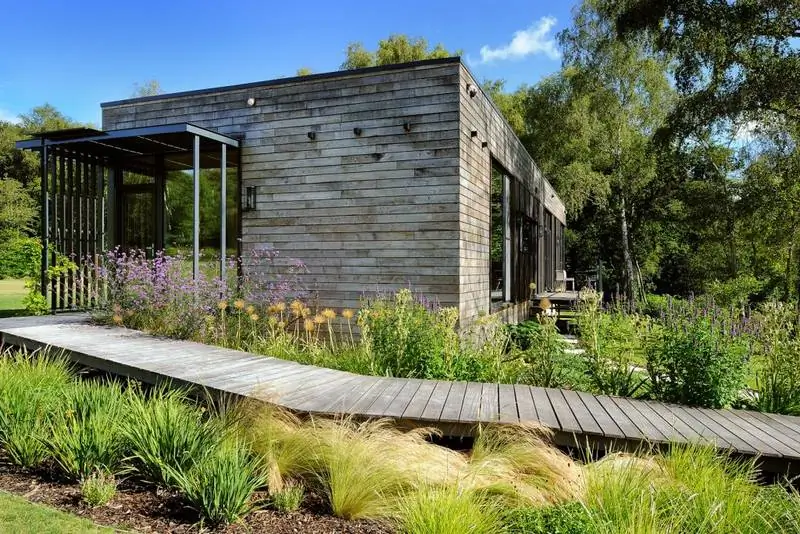 Image
Image
Структура в значительной степени облицована горизонтальными досками из необработанного каштана, но вертикальные участки облицовки, сделанные из темно-окрашенного сладкого каштана, добавляют разнообразия фасаду.
Он расположен на поляне среди зрелых деревьев и доступен по длинной гравийной дорожке. Один конец прямолинейного блока опирается на известняковую платформу, чтобы выровнять постепенный уклон площадки.
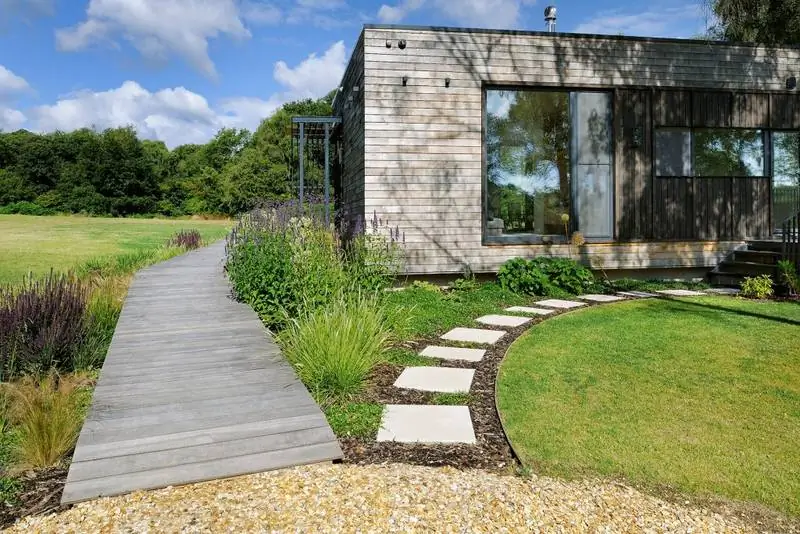 Image
Image
«Вертикальность деревьев и текстура их коры отражаются в различных видах обработки древесины, используемых при облицовке домов», – пояснил Перринг.
Западный фасад дома почти полностью застеклен, чтобы максимально открывать вид на лес. Отсюда обитатели могут выйти на приподнятую террасу и ухоженный сад.
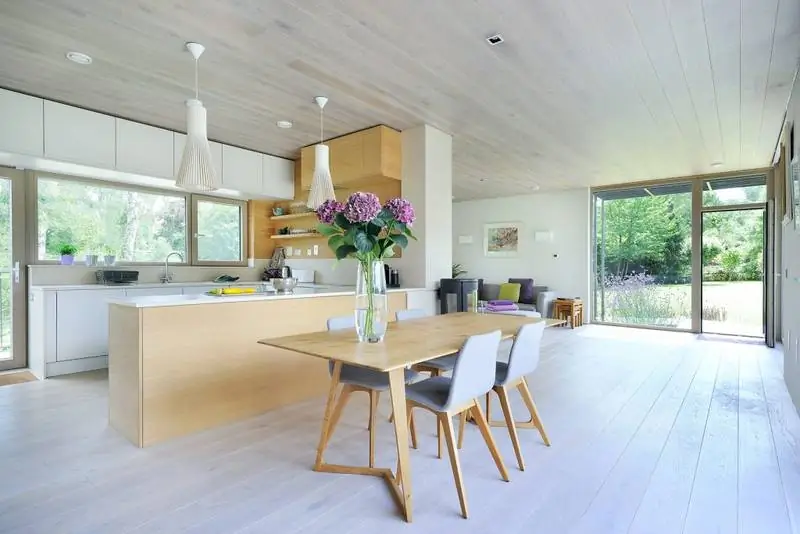 Image
Image
«Эти большие отверстия фокусируют и обрамляют потрясающие виды, отображая их внутри, как будто картины на больших холстах», – продолжил Перринг.
Внутри сдержанный цвет и материал поддона из светлого дуба, известняка и белых панелей предназначены для того, чтобы акцентировать внимание на видах. «Этот намеренно приглушенный массив материалов обеспечивает фон, который окрашен изменяющимся светом леса и представлен цветом ландшафта за пределами здания», – сказал архитектор
«Этот намеренно приглушенный массив материалов обеспечивает фон, который окрашен изменяющимся светом леса и представлен цветом ландшафта за пределами здания», – сказал архитектор.
«Сделанные на заказ столярные изделия, продуманные детали и связь с ландшафтом придают этому дому ощущение прочности, безмятежности и постоянства; вдали от предыдущего дома клиента».
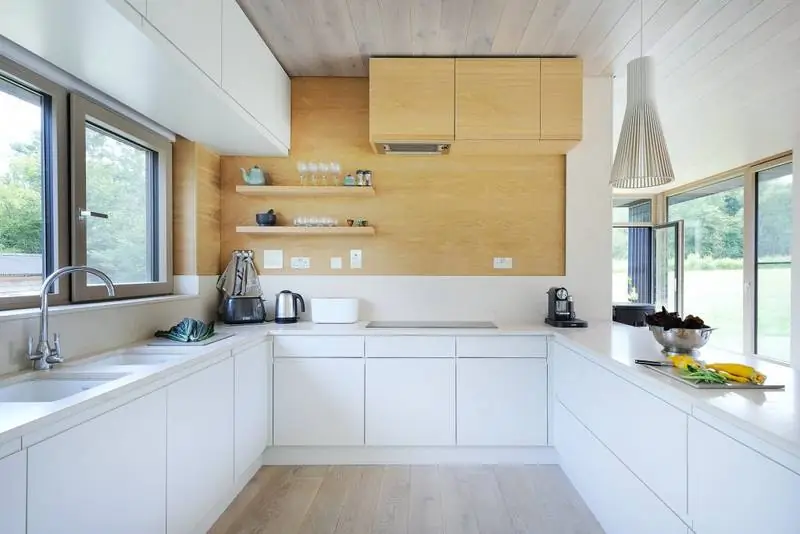 Image
Image
Спальня с односпальной кроватью расположена рядом с ванной комнатой на одном конце пространства. Объединенная гостиная, столовая и кухня занимают оставшиеся две трети плана.
Дом спроектирован так, чтобы соответствовать требованиям Passivhaus с низким энергопотреблением. Установленные на крыше солнечные панели, воздушный тепловой насос и очистные сооружения на месте означают, что дом в основном самодостаточен.
Green roof with a view
When French architect Djuric Tardio built this eco home on the outskirts of Paris, he wanted it to remain sympathetic to the pitched roofs of the local area, but without the large wasted attic space.
The solution: leave the pitched structure open and use it as a pergola for the family to grow their own fruit and vegetables, with a roof terrace beneath. The house was prefabricated with sustainable larch panels and assembled on site in two weeks, minimising construction waste and disruption – an important consideration when building eco homes. The 246sqm house also has a rainwater harvester for the plants, and super-efficient external insulation, so that the underfloor heating is hardly needed.
Photo: Clément Guillaume
Средиземноморский дом, Каталония
Конструкция этого дома, расположенного в муниципалитете Кастельдефельс, полностью сделана из дерева, и оба внутри указанной конструкции, так как снаружи установлена гибкая изоляция также из древесного волокна (жесткие панели в случае экстерьера). Ориентация с юга на север, большие окна на юг и восток, с двойным остеклением для защиты от солнечного света, которые вместе со ставнями и ставнями защищают от непогоды. падение солнца летом.
Качество воздуха в помещении гарантируется двухпоточной системой механической вентиляции с рекуперация тепла, в который добавлен аккумулятор для последующей обработки отработанного воздуха для его нагрева или охлаждения и который действует как основной кондиционирование дома.



